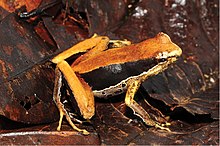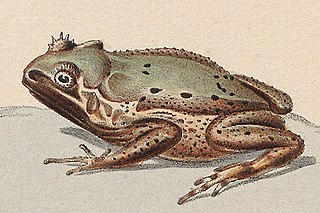
Asterophrys turpicola is a species of frog in the family Microhylidae. It is widespread in New Guinea and found in both West Papua (Indonesia) and Papua New Guinea, although it appears to be absent from the eastern half of Papua New Guinea. It also occurs on the island of Yapen, off the north-western coast of New Guinea. The species is known for its aggressive behaviour: it can attack and bite viciously.
Austrochaperina basipalmata is a species of frog in the family Microhylidae. It is endemic to the mountain ranges of northern New Guinea and is found between Tawarin River in Papua, Western New Guinea (Indonesia) and Torricelli Mountains in Papua New Guinea.
Barygenys exsul is a species of frog in the family Microhylidae. It is endemic to Papua New Guinea. It is known from Rossel and Sudest Islands in the Louisiade Archipelago, east of New Guinea. It is uncertain whether the specimens from Sudest really are conspecific with this species. Barygenys apodasta and Barygenys resima were mixed with this species prior to their description in 2013.

Callulops robustus is a species of frog in the family Microhylidae. It has traditionally been considered as wide-ranging species found in both Western New Guinea (Indonesia) and Papua New Guinea. However, it is likely that specimens from the type locality, Misima Island, and New Guinea represent different species. If so, name Callulops robustus belongs to the Misima Island species, and the mainland species is unnamed. Other island populations may or may not belong to Callulops robustus. Callulops microtis from the mainland has already been removed from synonymy with Callulops robustus.
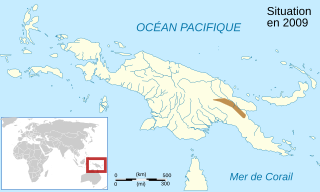
Cophixalus parkeri is a species of frog in the family Microhylidae. It is endemic to Papua New Guinea where it occurs in the central mountainous region between Chimbu and Morobe Provinces. The specific name parkeri presumably honours Hampton Wildman Parker, an English zoologist and herpetologist to whose perusal Arthur Loveridge sent the holotype. Common name Papua rainforest frog has been coined for it.

Cophixalus pipilans is a species of frog in the family Microhylidae. It is endemic to northern mainland Papua New Guinea and occurs between Lae and the Adelbert Mountains. The specific name pipilans is derived from the Latin verb pipilio and means "peeping". Common name Sempi rainforest frog has been coined for this species.
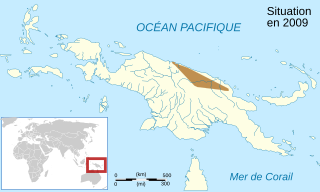
Copiula tyleri is a species of frog in the family Microhylidae. It is endemic to northeastern New Guinea and is found in both Western New Guinea and Papua New Guinea. The specific name tyleri honours Michael J. Tyler, Australian herpetologist who have worked extensively with Australian and New Guinean frogs.
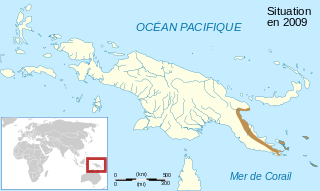
Sphenophryne thomsoni, sometimes known as Thomson's toothless frog, is a species of frog in the family Microhylidae. It is endemic to Papua New Guinea and occurs in the southeastern peninsular New Guinea, Louisiade Archipelago, d'Entrecasteaux Islands, and Woodlark Island. It was formerly in its own monotypic genus Genyophryne. The specific name thomsoni honours Basil Thomson, a British intelligence officer, police officer, prison governor, colonial administrator, and writer.
Mantophryne louisiadensis is a species of frog in the family Microhylidae. It is endemic to Rossel Island, a part of the Louisiade Archipelago in the Milne Bay Province of Papua New Guinea. Common name Louisiade archipelago frog has been proposed for this species. Mantophryne axanthogaster from the neighboring Sudest Island was formerly included in it.
Oreophryne atrigularis is a species of frog in the family Microhylidae. It is endemic to Western New Guinea (Indonesia) and known from its type locality, the Wondiwoi Mountains at the base of the Wandammen Peninsula, and from another location further east between Nabire and Mapia.
Oreophryne brachypus is a species of frog in the family Microhylidae. It is endemic to the island of New Britain, in the Bismarck Archipelago of Papua New Guinea. Common name Gazelle cross frog has been coined for it.
Oreophryne clamata is a species of frog in the family Microhylidae. It is endemic to West Papua, Indonesia, and known from the Wondiwoi Mountains at the base of the Wandammen Peninsula, Papua province. The specific name clamata, meaning "makes a loud noise", refers to its striking advertisement call. Common name noisy cross frog has been proposed for this species.
Oreophryne sibilans is a species of frog in the family Microhylidae. It is endemic to West Papua, Indonesia. It is known from east of the main ridge of the Wondiwoi Mountains at the base of the Wandammen Peninsula, in the Papua province. Similar frogs have been collected from the Yapen island and the Fakfak Mountains, but it remains to be ascertained that these represent the same species. The specific name sibilans refers to the whistling advertisement call of the species.

Xenorhina bidens is a species of frog in the family Microhylidae. It is endemic to New Guinea and found between Lorentz River in the west and Fly River in the east, thus being present in both West Papua (Indonesia) and Papua New Guinea. Common name Digul River fanged frog has been coined for it, in reference to Digul River where the type series was collected in 1904 or 1905.
Hylophorbus rainerguentheri is a frog species in the family Microhylidae. It is endemic to New Guinea and only known from the Huon Peninsula in the Morobe Province, Papua New Guinea. The specific name rainerguentheri honours Rainer Günther, a German herpetologist from the Natural History Museum, Berlin. Common name Huon Mawatta frog has been proposed for this species.
Papurana arfaki is a species of true frog, family Ranidae. It is widely distributed in New Guinea and also found on the Aru Islands (Indonesia). Common names Arfak Mountains frog and large river-frog have been coined for it. Its type locality is the Arfak Mountains.
Papurana supragrisea is a species of true frog, family Ranidae. It is endemic to New Guinea, including some nearby islands. It is known with certainty only from southeastern New Guinea and from the D'Entrecasteaux Islands. However, this name has been used more broadly for a species complex that is widely distributed in the mountains of New Guinea. Common name Papua gray frog has been coined for it.
Hylophorbus proekes is a species of frog in the family Microhylidae. It is endemic to Papua New Guinea and only known from the vicinity of its type locality on the southern slope of Mount Sapau in the Torricelli Mountains, West Sepik Province.
Mantophryne axanthogaster is a species of frog in the family Microhylidae. It is endemic to Sudest Island, a part of Louisiade Archipelago in the Milne Bay Province of Papua New Guinea.
Oreophryne phoebe is a species of frog in the family Microhylidae. It is endemic to Woodlark Island, Papua New Guinea.
